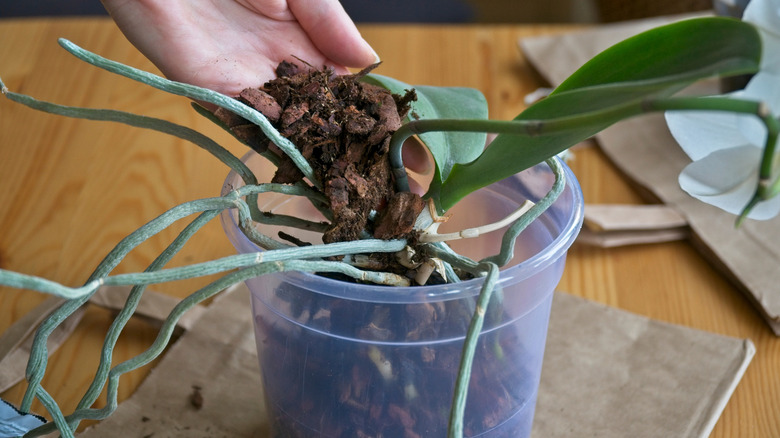How To Get Phalaenopsis Orchid To Bloom In The Winter
Don't treat your orchid like a bouquet of flowers! Once your pretty plant is done blooming, it's a shame to throw it away when it can be coaxed into many more floral shows. Beautiful Phalaenopsis orchids (also known as moth orchids) show off butterfly-shaped flowers in white, yellow, pink, purple, and shades of reddish orange. Phalaenopsis orchids can rebloom with the right care, even in winter. Keep your Phalaenopsis orchid happy and healthy all winter long with some temperature and water control, and blossoms should appear in a few months to brighten your home while your outdoor plants hibernate.
Phalaenopsis orchids kept indoors tend to bloom at any time, once a year (sometimes twice), and they hold onto their flowers for months at a time. But if your orchid is flowerless, and you're eager to see a bit of floral color sooner than later, winter is a great time to encourage some buds to emerge. Start by snipping off bare flower spikes about ½ inch from their base. Create cool nights for your orchid for at least 3 weeks by placing it in a spot between 55 and 65 degrees Fahrenheit overnight, or keep it near a cool window away from heaters and ducts. Cut back on watering during this time, but don't forget the importance of light. The University of Maryland Extension shares that low light is the biggest reason why an orchid doesn't bloom. Once your orchid's new flowers open, avoid nighttime temperatures below 65 degrees Fahrenheit.
Post-bloom care to ensure future flowering
Once your Phalaenopsis blossoms fade, a bit of attention can improve the likelihood of your moth orchid setting flowers on repeat. Orchids can be finicky plants, so along with temperature and water adjustments, a few other smart maintenance steps can keep the flowers coming regularly. Some pruning, well-timed repotting, and a few other guidelines can increase your moth orchid's chances of setting winter buds. After all, a healthier plant is more apt to bloom than a stressed one.
After trimming off the flower spike, see if your moth orchid needs to be repotted. Housing them in clear plastic pots makes it easier to know when the bark in the growing medium is breaking down and limiting air flow to the roots. The plant won't need a bigger pot, just some new potting medium that provides better airflow. Chunky bark best mimics orchids' natural growing environment, which is on the sides of trees.
Before settling your moth orchid into its new potting medium, trim away any withered or dead roots with sterilized scissors. Give the repotted orchid a thorough soak by running water through the pot. While your moth orchid isn't blooming, use specialized orchid fertilizer monthly, and water it no more often than every 10 days. However, if it's a mini Phalaenopsis, you should water it weekly. Low light and overwatering are common problems that prevent moth orchids from growing, so keep these two factors in mind as part of regular orchid care.

